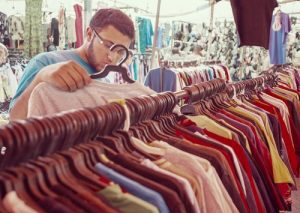Building a personal fashion collection by using items from an earlier era or owner is a practice that is increasingly becoming in vogue given the challenges of wasteful fashions and the overflow of landfills. Many studies show that millennials are now turning to the process of thrifting – which was at a time a less than desirable activity – in order to save a substantial amount of their disposal income, keep up with constantly changing trends, and avoid participating in the clothing practice where items, once discarded, are immediately diverted to landfills. By participating in a solution where millennials are harkening back to trends of the fashionable past, these young people are also doing their part to cut back waste and reduce landfill overflow. A recent U.S Environmental Protection Agency study estimates that Americans dispose of nearly 10.5 million tons of textiles annually (which translates to nearly 70 pounds of clothing and textiles per US citizen). We now know that this phenomenon is in large part due to the rise of “fast fashion” – which while it is cheaper (to make and buy) and lower quality grade, is also devastatingly costly to the environment. Thankfully, the rise of fast fashion has also meant that consumers are donating clothes in much larger amounts than ever have before. Statistics indicate that in the United States alone, citizens donate nearly 5 billion pounds of clothing and other miscellaneous materials yearly.
There is a potential problem that arises from excess donations. That is, as used clothing donations increase exponentially, so too does the need to find alternative spaces to house excess donations that do not sell when these thrift stores and vintage shops need to release items. One of the viable solutions to dealing with these excess materials, and as a result, dealing responsibly with landfill waste, is engaging in textile recycling – particularly the ‘mixed rags’ market.’
 For those unfamiliar with the Mixed Rags market, it often includes a wide range of items: clothing, shoes, and even household textiles such as linens and towels. This category of materials usually encompasses clothing items that vintage stores, and other business with similar products, are no longer able to sell. The reason for this difficulty might be because the item was deemed imperfect (clothing might have stains, rips, broken or jammed zippers or missing buttons or clips), was not sold/not suitable for resale, and/or was the result of a store return among other reasons. Once these items are deemed ready for the mixed rags market, they are turned over to the textile recycling organizations. However, before that happens, these items have to first be donated to a thrift store or to charity spaces, and retailers must have attempted to sell the items. Once this process is completed, retailers then remove the items from circulation and they re-orient them to a warehouse for other buyers to make use of. Upon their arrival at designated warehouses, workers in the mixed rags market then sort out the items, clean them and compress into bales, and store them until they can be/are sold.
For those unfamiliar with the Mixed Rags market, it often includes a wide range of items: clothing, shoes, and even household textiles such as linens and towels. This category of materials usually encompasses clothing items that vintage stores, and other business with similar products, are no longer able to sell. The reason for this difficulty might be because the item was deemed imperfect (clothing might have stains, rips, broken or jammed zippers or missing buttons or clips), was not sold/not suitable for resale, and/or was the result of a store return among other reasons. Once these items are deemed ready for the mixed rags market, they are turned over to the textile recycling organizations. However, before that happens, these items have to first be donated to a thrift store or to charity spaces, and retailers must have attempted to sell the items. Once this process is completed, retailers then remove the items from circulation and they re-orient them to a warehouse for other buyers to make use of. Upon their arrival at designated warehouses, workers in the mixed rags market then sort out the items, clean them and compress into bales, and store them until they can be/are sold.
The process of processing clothing through the mixed rags market does indeed come with its benefits according to re-sellers. On the one hand, nearly 45% of these materials are sold as secondhand clothing – which is an incredibly high number. Aside from those that are immediately sold in their secondhand condition, some items are also remade into other useful products for automotive, home improvement and manufacturing industries; fibers to stuff couches, chairs, carpet padding, and home insulation with; and even source material to make various technology items with (for example, items like tablet and phone cases).
Bank & Vogue is proud to be an active member of the mixed rags market as we recognize the importance of this product to ethically address our present-day environmental crisis and achieve the sustainability in the textile industry that is needed to clean the environment. By participating in the mixed rags market, Bank & Vogue has willingly played an active and responsible role in addressing the crisis while also providing willing customers with items that they need and desire.







